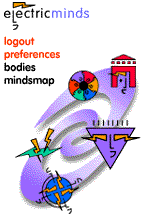
|

|

Geographic Information Systems (GIS) are visible maps that are combined with computer databases. The elements of the map, from streetcorners in urban systems to creekbeds in wilderness surveys, serve as windows into the database. Click on the streetcorner and see the income level of the neighborhood, or where telecommunications networks are distributed. Click on the creekbed and look at the underground resources, or see how the surrounding forest looked ten years ago, a hundred years ago. Many databases can be overlaid on the same map, and the entire collection of information can be made available, and continuously updated, through the Internet. GIS can be used as a political weapon as well as a scientific tool. GIS proved to be a potent political instrument in Bill Clinton's 1992 campaign strategy: Databases combined voting patterns with precinct maps and literally made visible to campaign planners the concentrations of "Reagan Democrats" who were crucial to Clinton's strategy. By knowing where to concentrate resources, the Clinton team gained a strategic advantage. GIS is certain to be used even more widely by both sides in the 1996 election. Another political use of GIS is to uncover "redlining," illegal exclusion of specific racial groups by realtors in certain areas. Because it makes patterns and trends visible in a map form, instead of representing them abstractly as numbers and graphs, GIS can be either an exploratory tool, like a microscope, or a tool for advocacy, like a printing press. Political activists can amplify their influence by showing decision makers what they are talking about. Eric and Steve Beckwitt of the Sierra Biodiversity Institute helped convince the U.S Congress to preserve some old-growth forests in California by using GIS to demonstrate how big the forest used to be, and how little is left. SBI is a founding member of The Conservation GIS Consortium. And a Portland, Oregon-based group, Ecotrust, successfully teamed up with GIS specialists to convince the government of British Columbia to protect the remaining remnants of North America's rainforest from logging. According to Erin Kellogg, Ecotrust's director of policy and communications, "Kitlope Valley in British Columbia is part of the surviving remnant of this continent's temperate rainforest. We gathered information about temperate rainforests from a wide variety of sources and published a report illustrated with GIS maps. The map-illustrated data proved to be a key element in our political strategy." Sometimes, the objective of GIS is to stimulate insight in the mind of an expert -- the power to understand the way a watershed evolves, or the relationship between geographic features and the presence of petroleum, for example. Sometimes, the objective of GIS is to stimulate insight in the mind of a voter or decision-maker. In either kind of use, GIS helps people think about issues that otherwise would be too abstract to grasp easily. The unexpected collision of two unrelated technologies sometimes creates an altogether new technology with properties of its own. Put a television screen together with a typewriter keyboard and a microprocessor, and you get a personal computer. Combine computers and telecommunication networks and you get the Internet. Maps are an ancient communication device, computers are more recent. In combination, these two tools have spawned something new and powerful, and therefore worth keeping an eye on. Internet GIS resources:
Join the conversation about GIS and online maps. |
librarybob said: I think it would be useful to distinguish between "innate ability" and "the result after many years of acculturation and schooling" to define "dumb". I wouldn't think it likely that there has been an innate (genetic) change, so that if people have indeed been dumbed down, it must be due to environmental causes. Actually, maybe "dumbed down" isn't quite right--maybe very committed to "low" and "mid" culture that really doesn't demand much thinking. A problem I see is that both of these are "ahistoric," living in the here and now with little sense of a past and little sense of a future. They lack a larger context. Most Active Topics: Topic 45 The Future of Families Topic 42 Library of Tomorrow: 20 Questions (game) | |||
Because it makes patterns and trends visible in a map form, instead of representing them abstractly as numbers and graphs, GIS can be either an exploratory tool, like a microscope, or a tool for advocacy, like a printing press. | ||||
Also in Howard Rheingold's Tomorrow: Collaborative Filtering excerpts from "What Will Be" Digital Maps: | ||||
|
|
|
electric minds |
virtual community center |
world wide jam |
edge tech |
tomorrow |
conversations
Any questions? We have answers.
©1996, 1997 electric minds, all rights reserved worldwide.
|
